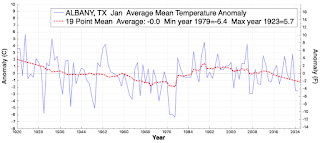Daily data about HCN stations and adjusted data from NOAAS and GISS
Monday, February 24, 2025
Tuesday, February 11, 2025
Outlier stations (another post that is pretty much just for my use)
Outlier stations are what I call USHCN stations where the data is wildly different from the majority of climate stations. I don't know why this is, but I don't use them when looking at trends. It is definitely not always the UHI
Looking at all of the US it is clear that there is a regional climate change, that doesn't seem to fit the Bruckner cycles. Speaking of, out of all the USHCN stations, only Dale Enterprise shows clear cycles when using Tmin data, which is very cool, and I have found no publications online that mention it.
I probably have a post about this elsewhere but I don't feel like looking for it right now
Here is an example of an outlier from VA, Lincoln USC00444909
It does not show the well known cooling starting in the mid 50s, and shows far too much cooling after 1995, compared with other quality stations in the Eastern US
If you are reading this, remember this is the actual data from stations, no alterations of any kind.
Precipitation data from that station also does not match other stations in the region.
Related stations and climate change (shout out to Michael E. Mann)
Many years ago I read something from
Michael E. Mann
about related stations. He said that station related in space to each other showed the same trends, and you could use stations 500 miles apart to get an idea of how large areas are changing. My own research confirmed this, especially if you don't use outlier stations, where the data does not match the majority of stations.
Subscribe to:
Comments (Atom)
Why this blog?
Using GROK to advance science, what used to take months takes minutes
Complicated polar vortex conversation Time spent with GROK is priceless
-
Extreme. Not possible to even explain away with the "adjustments", which makes all the other "extreme warming" on the ...
-
Climate Central is pushing the narrative that winters are warming the fastest, and all seasons are warming. This is because the basic glo...

























